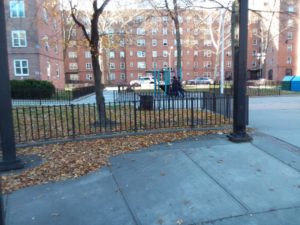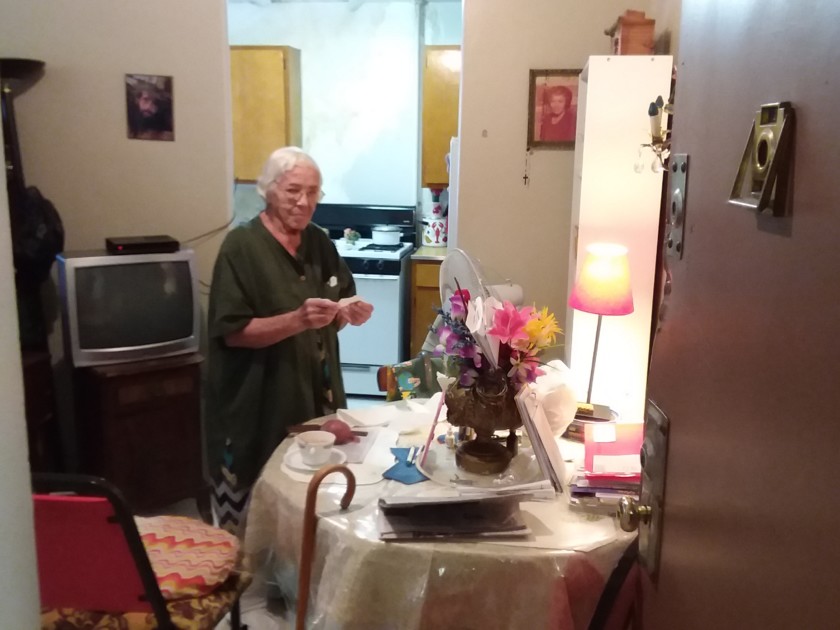
At age 93, living alone in a New York public housing apartment is not easy. Humbelina Batallan’s list of discomforts starts with the elevator doors that tend to get jammed in Red Hook Houses, Building 442. Although she only lives in the second floor, climbing the fifteen cruddy metal steps up the narrow stairway is not an option in her current state. Her feet and legs are covered in bandages that protect flesh left sore and swollen after a surgical procedure to remove veins.

Wearing a pair of loose slippers, a white and blue skirt, and a green dress, she stands in the hallway to greet guests and welcome them into her home. The door is usually open. “It keeps the air fresh,” says Batallan.
But it is the condition inside her home that bothers her the most.
Walking slowly, she points to the burst ceiling, the chipped paint, and the watermarks on the walls of her four rooms, and to other problems. “It is horrible to live like this,” she says. She complains that the New York City Housing Authority (NYCHA) simply ignores her requests to fix the walls and ceiling.
However, she is determined to get the repairs done. With that in mind, she went last Monday to the Red Hook Community Justice Center, on Visitation Street, accompanied by two neighbors. One of them, Carmen Cantres, 68, also wanted to get her apartment fixed. The other, Juana Narvaez, 63, had already managed to get NYCHA to fix hers by going to the court and is trying to help her two neighbors.
It is difficult to live in a damaged, mold-infested, without-heat-for-days-during-winter home. Narvaez has complained about these things, and so has Council Member Vanessa Gibson. “It would be one thing if we were just dealing with lead-based paint, but unfortunately because of the challenges in NYCHA and the challenges that families face every day, it’s compounded with heat and hot water, and rodents, and malfunctioning elevators, and poor lighting, and scaffolding, and gas outages…,” Gibson said, stirring a burst of applauses during a December 5th hearing about lead paint in public housing. Still, learning from the news media that the bits of paint coming off the walls and ceiling could in fact be a neurotoxic poison is at least equally discomforting.

The Red Hook Houses, with 2,878 apartments, are Brooklyn’s largest public housing development. They were built in 1939, 21 years before lead paint was banned in New York City. The City Housing Authority estimates that 48,000 of the 176,000 apartments citywide have lead-based paint, 4,200 of which have children under six living in them. Children under six are the population most at risk, because they are more likely to put things into their mouths, like paint chips or lead-dusted fingers, and because they absorb the poison into their bloodstream more quickly than adults.
Between 2010 and 2016, more than 7,700 children in New York City were found to have elevated lead blood levels, but only 21 apartments affecting 19 children were found to be the reason for the poisoning. According to this data, apartments would rarely be the reason children are poisoned with lead. But this prompted Council Members to question how the authority connects a child´s high lead level with the home that he or she lives in. Council Members also questioned the certification of those conducting the lead inspections. According to officials, the city has only 30 staff members certified by the EPA to conduct lead tests, and 300 more that have received some level of training, often online.
Adverse health effects from lead paint can be permanent, affecting the development of the brain and the nervous system. In adults, it may cause nerve disorders, high blood pressure, and kidney damage, among other effects, but poisoning of adults happens more frequently at work, not at home, and mainly in construction. Therefore, New York City Department of Health only conducts routine studies of children under six.
Luz Martínez, another Red Hook senior, lives in a different NYCHA apartment, on West 9th and Columbia Street, with her three grandchildren, a 17-year-old and two 3-year-old twins. She says she is worried because the paint on her walls is chipping off. “I have to leave the hallway light on so that I can see that the children aren’t there,” she said during an interview. Her fear is that the paint is contaminated with lead.
Ironically, Martinez couldn’t go to City Hall to testify in December 5th’s hearing about the Housing Authority’s lead-paint inspections, because she was expecting a visit from city Housing Inspectors at her home.
During the hearing, Shola Olatoye, the chair and chief Executive of NYCHA, was repeatedly questioned by City Council members not only for suspending lead-paint inspections, but for certifying under oath that inspections had been carried out, when it was found that the authority was not in compliance. The law requires that NYCHA to inspect 4,200 apartments where children under the age of six live, but for four years these weren’t conducted. The significance of the lapse was highlighted at the hearing by Dr. Arminia Palacio, Deputy Mayor for Health and Human Services, who acknowledged that “lead-based paint remains the primary source of childhood lead exposure in New York City,” although she also stressed that the poisoning by lead in children has decreased by 70 percent since 2005.

Statistics, however, were of little comfort for Sherron Paige, mother of four-year-old Kyan Dickerson, whose blood has tested elevated for lead. “From NYCHA’s neglect of my apartment, my child is now suffering with delayed speech and behavioral issues,” she told the committee. She further complained that NYCHA employees “treat us like second class. We don’t get nothing done,” she said. “Till this day I have a leaking pipe in my bathroom.”
Batallan and Cantres expect someone from the Center in Brooklyn will show up at their homes next December 12 to certify the conditions of their apartments. On January 4th, they’ll have to go back to the court. Perhaps then, they hope, the Red Hook Community Justice Center will get NYCHA to fix up the places where they live.


Leave a Reply